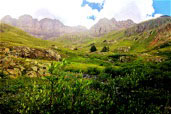SOUTHWEST SEMINARS PRESENTS
MOTHER EARTH, FATHER SKY
PERSPECTIVES ON NATURAL SCIENCE AND THE ENVIRONMENT OF THE AMERICAN WEST 2013
 TO ACKNOWLEDGE AND HONOR THE WORK OF THE NEW MEXICO ENVIRONMENTAL LAW CENTER
TO ACKNOWLEDGE AND HONOR THE WORK OF THE NEW MEXICO ENVIRONMENTAL LAW CENTER
MONDAY NIGHTS AT 6 PM AT HOTEL SANTA FE
October 21 Dr. Eske Willerslev
DNA Researcher and Evolutionary Biologist, Director, Centre of Excellence in GeoGenetics and the National CryoBank and Sequencing Facility, National History Museum and Biological Institute, University of Copenhagen, Denmark; former Full Professor, Niels Bohr Institute and Visiting Professor, Oxford University
Our Human Genome and American Indian Continental Migrations
October 28 Leigh J. Kuwanwisiwma (Hopi)
Director, Hopi Tribe Cultural Preservation Office; Author ‘Yupkoyvi: The Story of Chaco Canyon’, in
In Search of Chaco: New Approaches to an Archaeological Enigma (D.G. Noble, ed.) Recipient, 2013 Governor’s Arizona Archaeology Advisory Commission ‘Public Archaeology Award’ and 2012 Governor’s Arizona Centennial Historic Preservation Award
Hopi Culture: Then and Now
November 4 Wayne Ranney,
Geology Educator, Grand Canyon Field and Author, Carving the Grand Canyon: Evidence, Theories, Mystery; Sedona Through Time: A Guide to Sedona Geology; (winner, Best Science Book in Arizona, 2011); ‘Defining the Colorado Plateau: A Geologic Perspective’; ‘The Verde Valley: A Geological History’; ‘Canyon Country’ (all in Plateau); Co-Author (w/R. Blakey); Ancient Landscapes of the Colorado Plateau; and (w/ C. Bowden and J. Dykinga) Images: Grand Canyon; and Instructor, Honors Program, Northern Arizona University, Flagstaff
How Old Is the Grand Canyon?
November 11 Dr. Paul Zolbrod
Translator, playwright, professor and scholar; Professor Emeritus of Literature, Allegheny College
Adjunct Instructor, Dine College, Crownpoint; Research Associate, Museum of Indian Arts and Culture
Author, Dine Behane: The Navajo Creation Story; Sacred Texts; Reading the Voice: Native American Oral Poetry on the Page; Co-Author (w/ R. Willink) Weaving a World: Textiles and the Navajo Way of Seeing.
A Navajo Myth for Hunting and The Natural World of Animals
November 18 Dr. Richard I. Ford and Dr. Glenna Dean
Dr. Richard I.Ford: Ethnobotanist, Archaeologist, Professor Emeritus of Anthropology (ret.) and Former Curator of Ethnology & Ethnobotany, Museum of Anthropology, University of Michigan; and Editor, The Nature and Status of Ethnobotany. Dr. Glenna Dean: Associate Director, Northern Rio Grande National Heritage Area; Former NM State Archaeologist; Specialist in soil samples & pollens; textile weaver, plant-dye, hand spinner
Aboriginal Cotton Production in Northern New Mexico: Archaeological and Ethnographic Perspective
November 25 Dr. Henry Wright,
Member, United States National Academy of Sciences and Chinese Academy of Social Sciences; Albert Clanton Spaulding Distinguished University Professor of Anthropology and Curator of Near Eastern Archaeology, Department of Anthropology and Museum of Anthropology, University of Michigan; Member, Science Board and External Professor, Santa Fe Institute; Author, ‘Cultural Action in the Uruk World’, in Uruk Mesopotamia and its Neighbors: Cross Cultural Interactions in the Era of State Formation, (M. Rothman, Ed.); ‘Trade and Politics on the Eastern Littoral of Africa: A.D. 800-1300’, in The Archaeology of Africa: Food, Metals, and Towns, (T. Shaw, P. Sinclair, B. Andah, A. Okpoko, eds.); ‘The Culture History of Madagascar’ (w/ R. Dewar), in Journal of World Prehistory.
What Can We Learn From Old Civilizations?
December 2 Dr. Dean Falk
Evolutionary Anthropologist and Senior Scholar, School for Advanced Research on the Human Experience; Former Hale G. Smith Professor of Anthropology, Florida State University
Author, Fossil Chronicles: How Two Controversial Discoveries Changed Our View of Human Evolution
The Fossil Record of Human Brain Evolution
December. 9 Dr. John Ware
Social Anthropologist and Archaeologist; Executive Director, Amerind Foundation, Dragoon Arizona, Research Associate, Museum of Northern Arizona; Arizona State Museum, University of Arizona; School of Advanced Research (SAR); Member, Board of Directors, Arizona Humanities Council;
and Author, A Pueblo Social History
A Pueblo Social History
December 16 Dr. Leo Killsback (Northern Cheyenne)
Assistant Professor of American Indian Studies, Arizona State University, Tempe, Arizona; Author, The Chiefs’ Prophecy: The Destruction of Original Cheyenne Leadership During the Critical Era, 1876-1935; Specialist on Tribal Government, Tribal Law, and American Indian Culture and Spirituality
Our Spiritual Relationship With the Earth
$12 at the Door or $90 for the Series of 9 Lectures
Comments are closed.